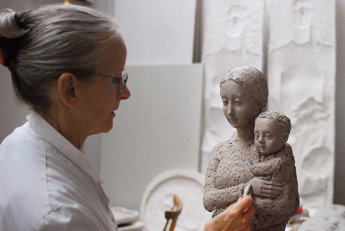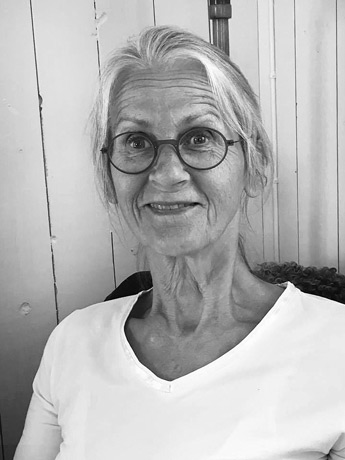From the depths of memory
For many years, the Sculpture Project has had the opportunity to create unique sculptures in collaboration with some of Sweden’s most recognised artists. All of the artworks are based on an exciting combination of sand-cast recycled aluminium with its distinctive surface texture, industrial crafts- manship and artistic curiosity. The works are manufactured by experienced craftsmen at the Byarums Bruk foundry in Småland, Sweden. The fruit of this year’s collaboration is “Dreaming”, a work by sculptor Lena Lervik.
Infants are magical. They embody the hope of a brighter future. A dream of something different. Nobody has the ability to invoke such feelings of tenderness as these tiny creatures. No wonder we feel such love for them. When we cradle an infant in our arms, we experience an intense feeling of presence. The sculptor Lena Lervik expressed it like this: “When you have a newborn infant in front of you, all you can do is feel love and wonder at such a miracle. These moments remain imprinted in both the infant’s and our own psyche like a computer chip in the soul – a total, languageless presence between mother and child.”
This intimate connection is embodied in the sculpture by Lena Lervik which Byarums Bruk has produced out of recycled aluminium. The sculpture is reminiscent of those fragments that archaeologists – if they’re very lucky – find embedded deep in the soil. In this case, what we see is part of a face, a very special portrait. The sculpture depicts the head of an infant, reproduced from memory. A mother’s memory of her sleeping, dreaming baby. The infant’s name is Alexander, who is now in his 40s. Back then, in 1973, he was eight months old. He is one of Lena’s four children, represented here as “Dreaming Alexander”.
Lena Lervik has worked with images of pregnancy and motherhood throughout her entire career as a sculptor. A deep bond between mother and baby is established right from the womb. All manner of feelings, both happy and complex, are exchanged between them. As Lena Lervik once expressed in an interview: “We’ve all experienced moments of emotional fusion between mother and child. It is perhaps the most profound feeling of completeness that we can ever experience. Every human being has these memories. Even if only for a brief second, we’ve all known this absolute love.”
The mother nurtures the child through her own body: life first takes shape in the womb, the umbilical cord is a lifeline for the foetus, and the mother’s milk sustains the child after birth.
This morning I read a newspaper article on how infants perceive their surroundings, the importance of touch, and how infants learn to identify their mother’s smell from a very early stage. Touch and smell are the first senses to develop, followed by hearing and vision. Of course, sight is crucial to our perception of an artwork. But when perceiving a sculpture, touch plays an equally crucial role. Even if we’re not allowed to touch it, we can imagine feeling it with our hands and fingers. Our memory and perception of touch are fine-tuned from the moment we are born.
Lena Lervik’s sculptures are tactile. They exert a tangible presence. They affect the space in which they exist. Sculptures have a unique ability in this regard. This makes sculptures increasingly important as our living environments and public spaces become smaller in size and cities ever more dense. We humans sometimes require breathing space and an opportunity to reflect and feel unconditional presence in the moment. Sculptures can be seen as a response to this need.
Art critic Joanna Persman has described the central themes in Lervik’s art in the following way: “The ancient myths of the mother goddess are embodied in Lena Lervik’s sculptures. Since the mid- 1970s, she has consistently worked with Christian iconography in the form of the Madonna figure, and the ancient Nordic myths surrounding fertility goddesses. The cult of the mother is central to her work.”
As we have seen, Lena Lervik’s art is inhabited by ancient symbols that humankind has carried forward through the millennia. The seven wreaths of corn ears refer to Sophia, who in Eastern Orthodox Christianity represents the holy wisdom of God gained through humility. From an ear of corn, new ears sprout after the corn has rested (like Demeter) for six months in the dark, moist earth. The milk symbolises life’s abundance. The spiral symbolises waxing and waning, the sun and the moon. The vessel symbolises the water of life, the fish Christ. The dove is a symbol of peace. The beehive with its hexagons is a tantric symbol of love and the act of embracing.
Lena Lervik depicts fertility goddesses and biblical women whose roles and attributes have been interpreted and reinterpreted through the generations; women who were strong, wise, afflicted, victimised, nurturing and comforting. Women who both give life and protect it.
Her sculptures bring stillness to their vicinity. Because of this quality, they are frequently found in churches, one of the few places today where we can experience peace and quiet. At the time of writing, in 2020, people worldwide have been forced to radically change their way of life. We are confined to living apart, alone, or in restricted groups. This gives rise to a new mental state. An absorption in the present moment resulting in a new receptiveness to life and art.

Today Lena is 80 years old. The fact that she has had a studio in Skinnarviksberget for over 40 years is, like most things in life, a product of chance. And it was by an even more remarkable chance that she became an artist and sculptor. At the age of 20, she had just finished a job as an au pair in Paris. The host family had been demanding, and she was tired and bored. Where to next? She decided to visit the Riviera. At the railway station in Geneva, she bumped into a friend who was applying for the Ecole des Beaux Arts. She invited Lena to accompany her. The staff at the art school in Geneva assumed that Lena was also there to apply for admission. She filled out the application forms and was instructed to take part in the entry exams. On the first day, each applicant was given a piece of clay to transform into a sculpture. Lena’s first experience of clay was a revelation. She had found her material. She was accepted onto the course.
The lessons were challenging and the teachers were strict. The students had to arrive at 8 am every morning, and the lessons continued until 6 pm. Any latecomers and absentees were expelled. “But we learned a lot,” Lena says. “I completed two academic years in just one year. Then my money ran out and I had to return to Sweden.”
Determined to continue her art studies, she applied for the sculpture course at the Konstfack University of Arts, Crafts and Design in Stockholm. Her teacher there, Palle Pernevi, advised her to spend her time learning as much as possible about different materials and techniques and attending life drawing and sculpture classes. But after that, he advised, she should apply for the Konstakademien (Royal Academy of Fine Arts). He thought the teaching there would suit her better.
She got into Konstakademien the second time she applied. The sculpture studies there spanned an enormous breadth. Her teachers included professors Asmund Arle, Arne Jones and K. G. (Karl Göte) Bejemark – three eminent sculptors with many works installed in public places. But Lena came up against a problem. Could she find the time to complete her studies? She had married and given birth to three children in a short space of time. Her husband, a businessman, was often away for work. She had to stay home and tend to the children.

Then her father passed away. Daily life was challenging, and she confessed to K. G. Bejemark that she was considering giving up her dream of becoming an artist. He offered an alternative: “If you study part time for two years, you’ll have completed one academic year.” And that is what she did. She paid for childcare in kind by giving the nanny sculpture lessons.
Bejemark was something of a guardian angel during this period.
She now had a new husband, fellow sculptor Thomas Qvarsebo, and out of the blue, Bejemark suggested that the young couple take over his listed house and studio in the Söder area of Stockholm, and registered the change of proprietorship with the Stockholm municipal authorities. Ever since then, she has been sculpting in Bejemark’s beautiful old studio.
This is where her four children grew up, while she gave life to sculptures of mothers, women, Madonnas and children. Her CV lists several pages of public commissions and locations where her sculptures are exhibi- ted. And her portraits of female figures and Madonnas grace many churches. Ever since becoming a sculptor in the 1960s, Lena Lervik has been creating mother figures, fertility goddesses, earth mothers, children and modern mothers. Clay is an important part of her artistic process. It is a strongly physical material, but in order to give clay a soul, it is necessary to have a deep empathy with the subject portrayed. Lervik’s long life experience as a woman is clearly visible in her sculptures. She has distilled its very essence.
And what about Alexander – what became of that little being with an air of such calm? Who knows what’s going on in his little head? Does that hint of a smile on his lips suggest a happy dream? By a strange coincidence, I happen to know more about Alexander than about his mother. He was one of my students at Beckmans College of Design in the mid-1990s. Like his mother, he tended to delve beneath the surface in his various design projects. He portrayed the 20th century design history that I taught his class by creating a series of stools. Each stool embodied the design and dreams that prevailed during each period.
Today he is a renowned and successful designer, one of those talented innovators that make the world a more interesting, beautiful and magical place. Hanging on my wardrobe door is a small, white, three-dimensional pendant which he created using CAD/CAM scanning technology. It is based on a scan of his own brain, with all its crevices and beautiful bone-like structures. But the thoughts and dreams inside it are as mysterious and inaccessible as those of the slumbering baby Alexander. And that’s a wonderful thing. Without mystery, life would be devoid of magic, and we observers would lose our curiosity and sense of wonder.
For more information, download our press kit.
Text: Kerstin Wickman, Professor Emeritus in Design and Craft History.

